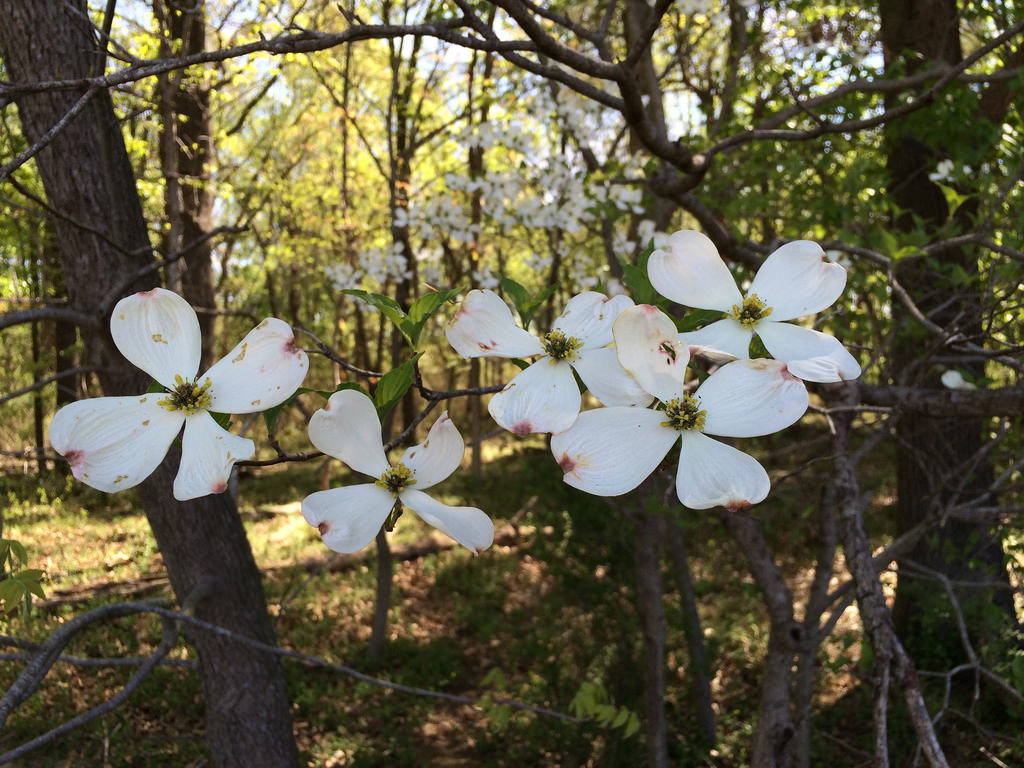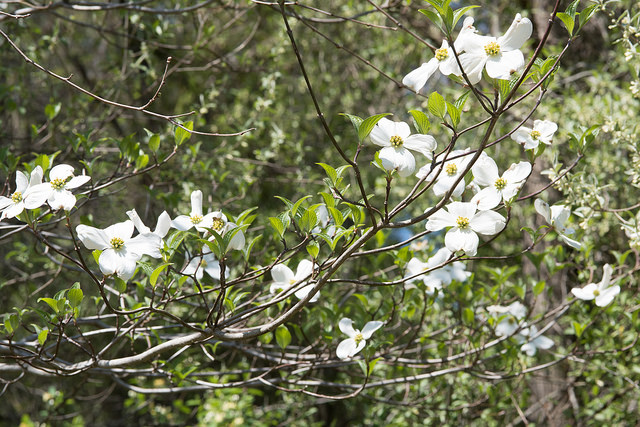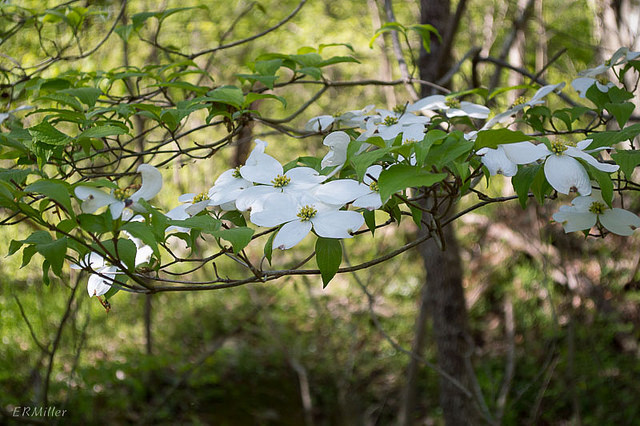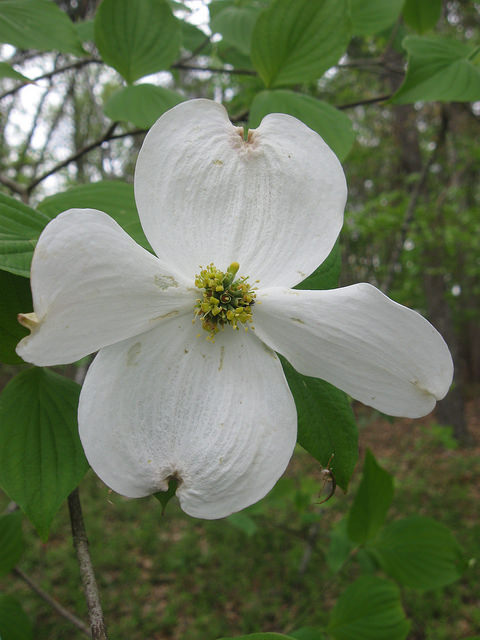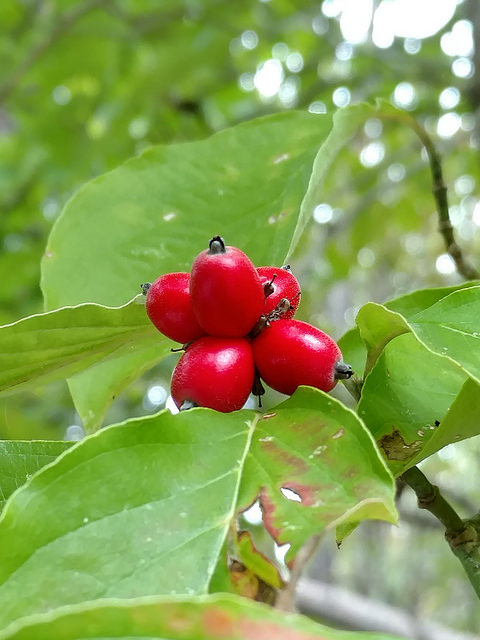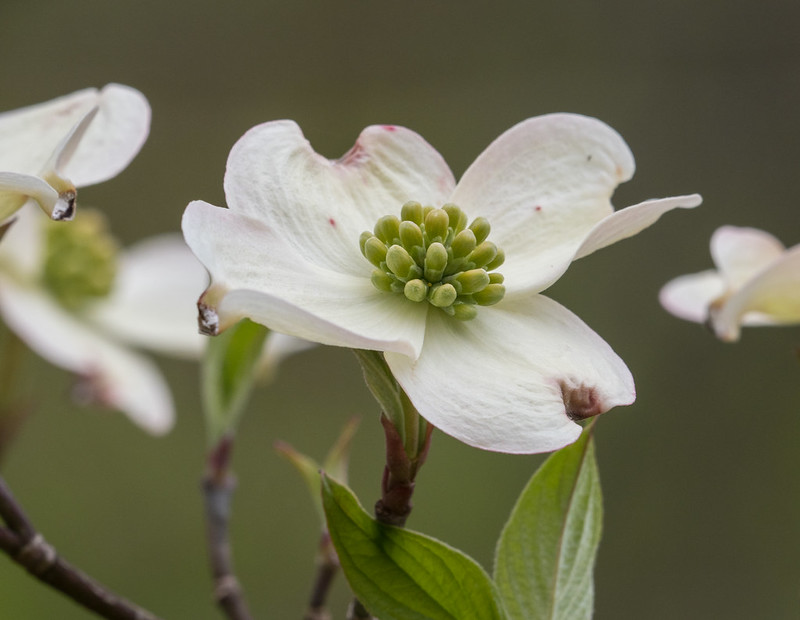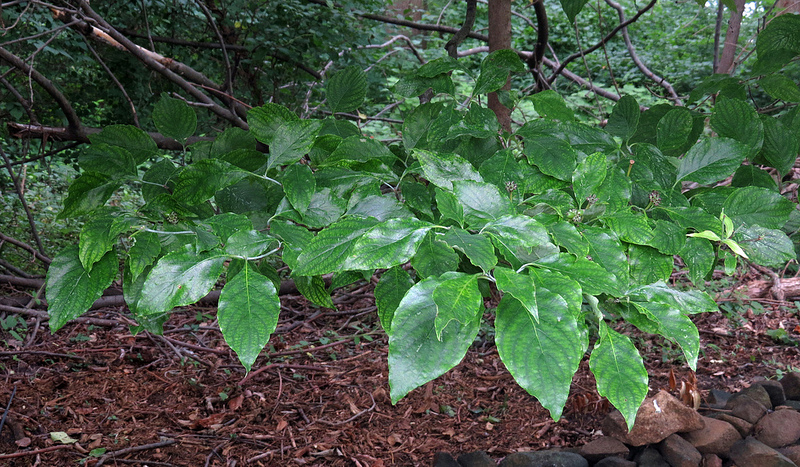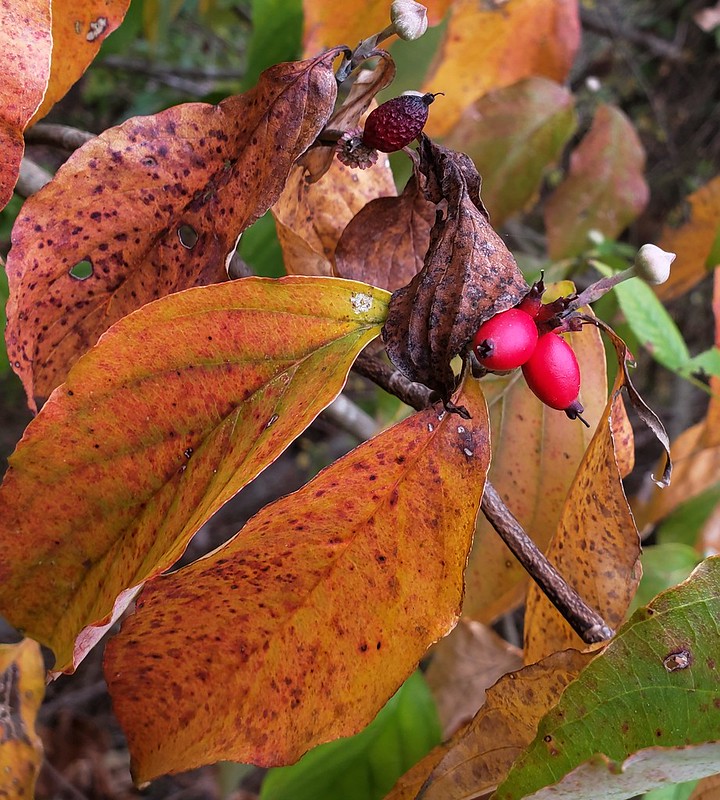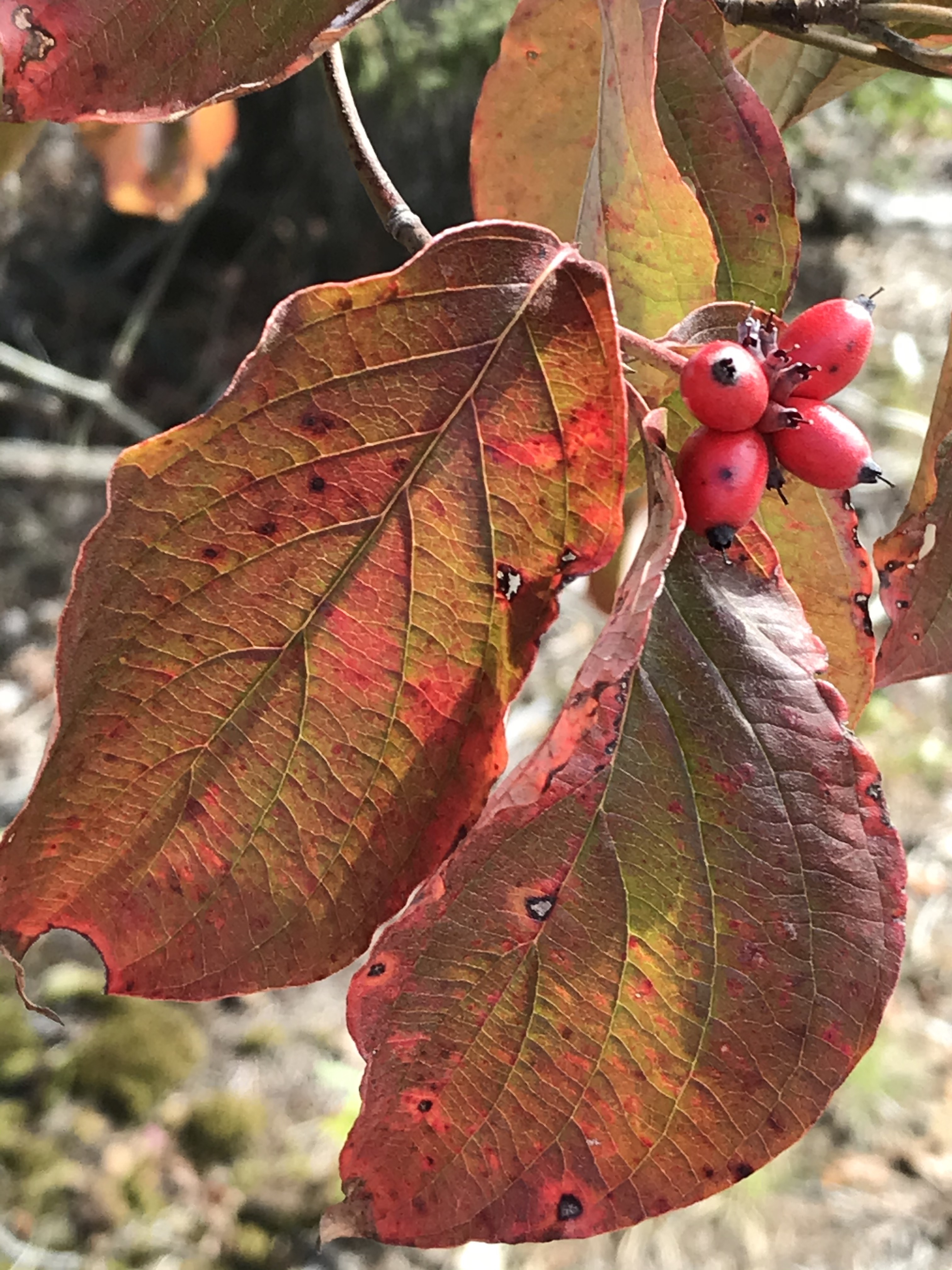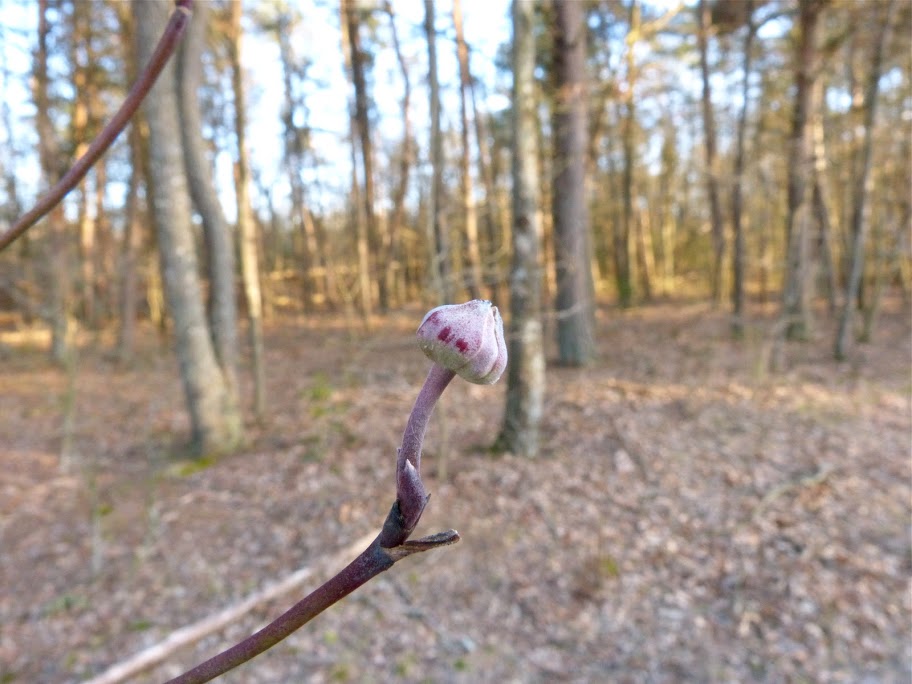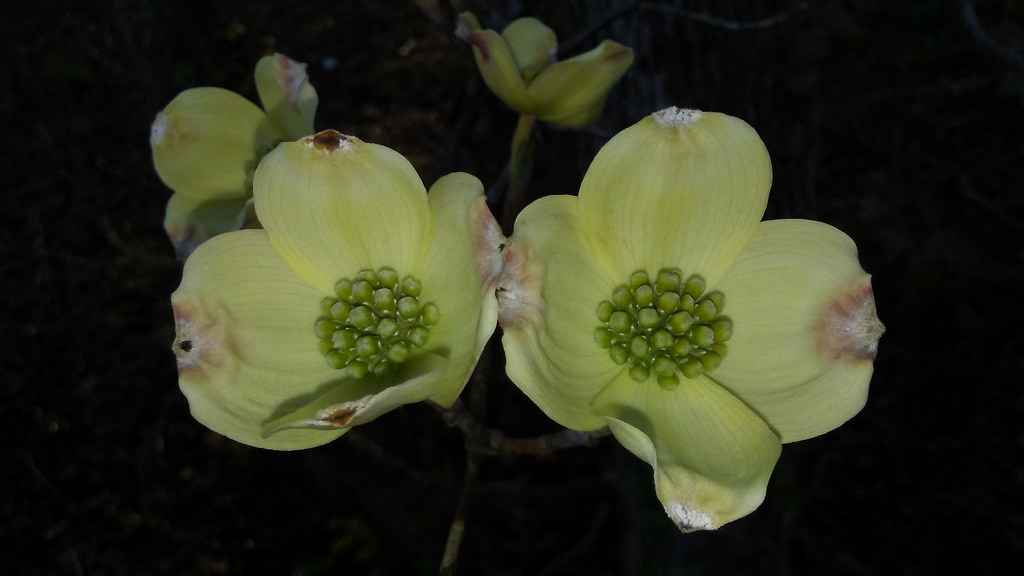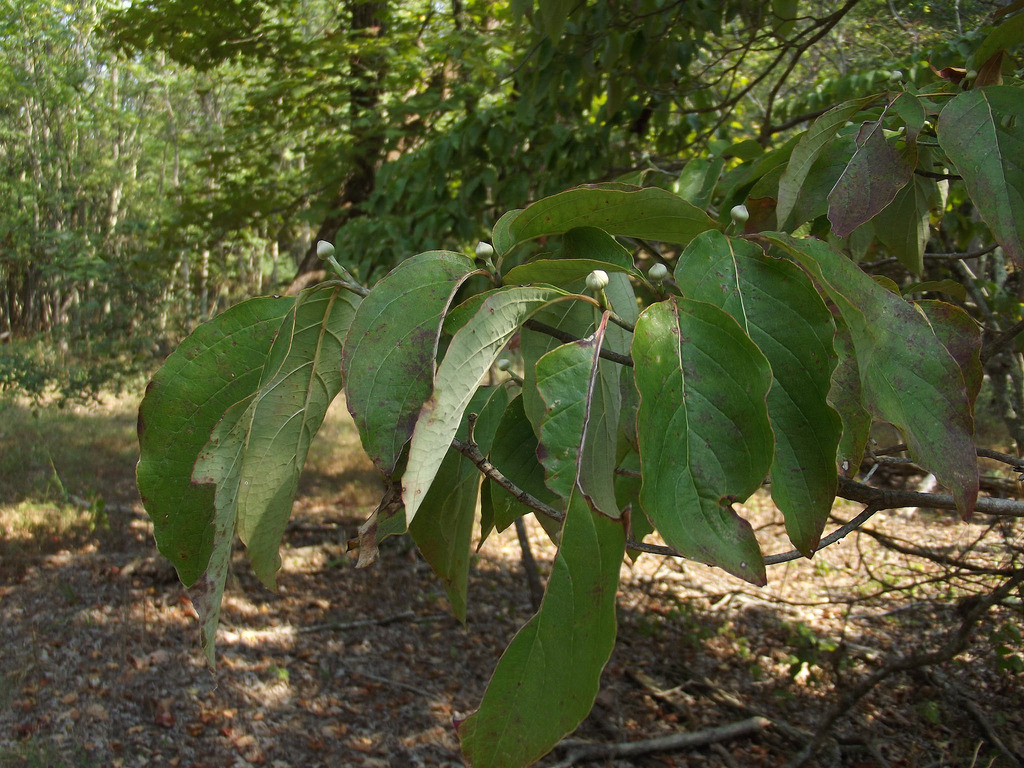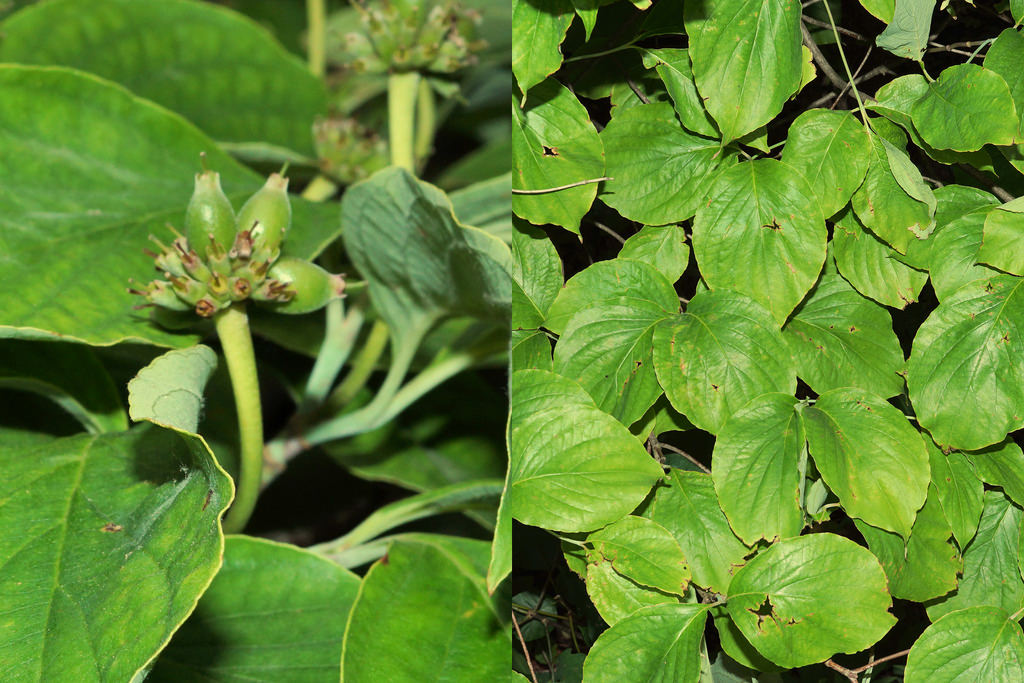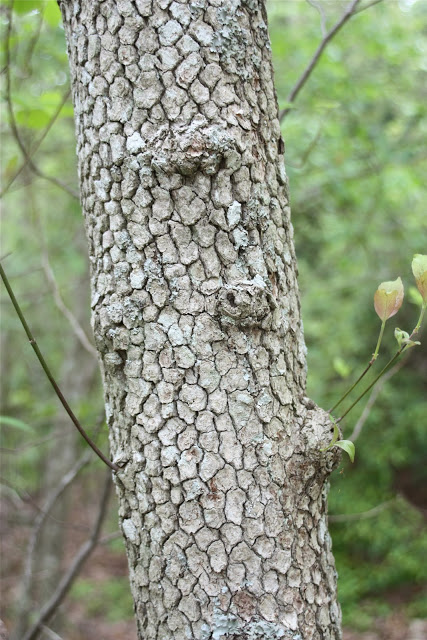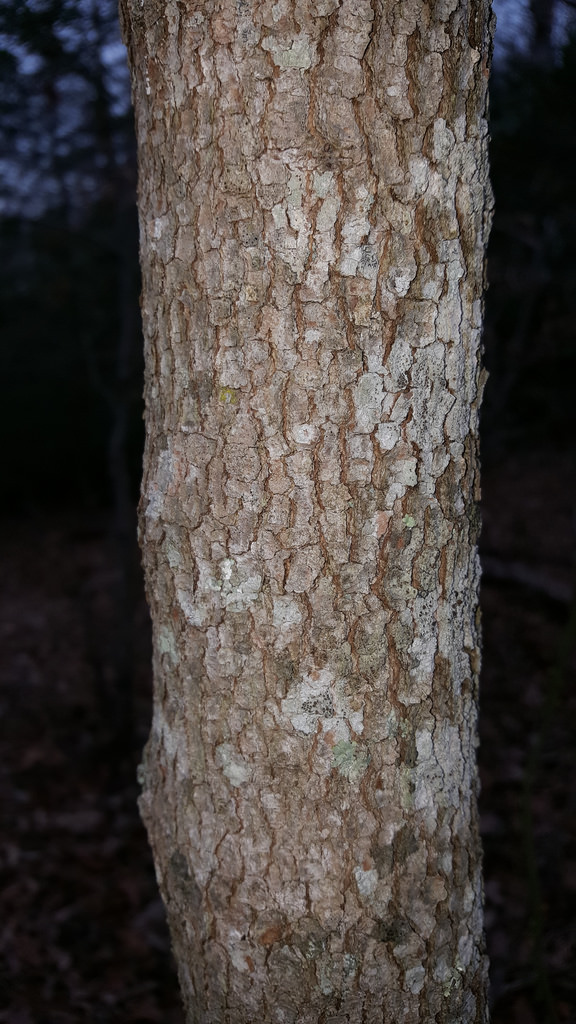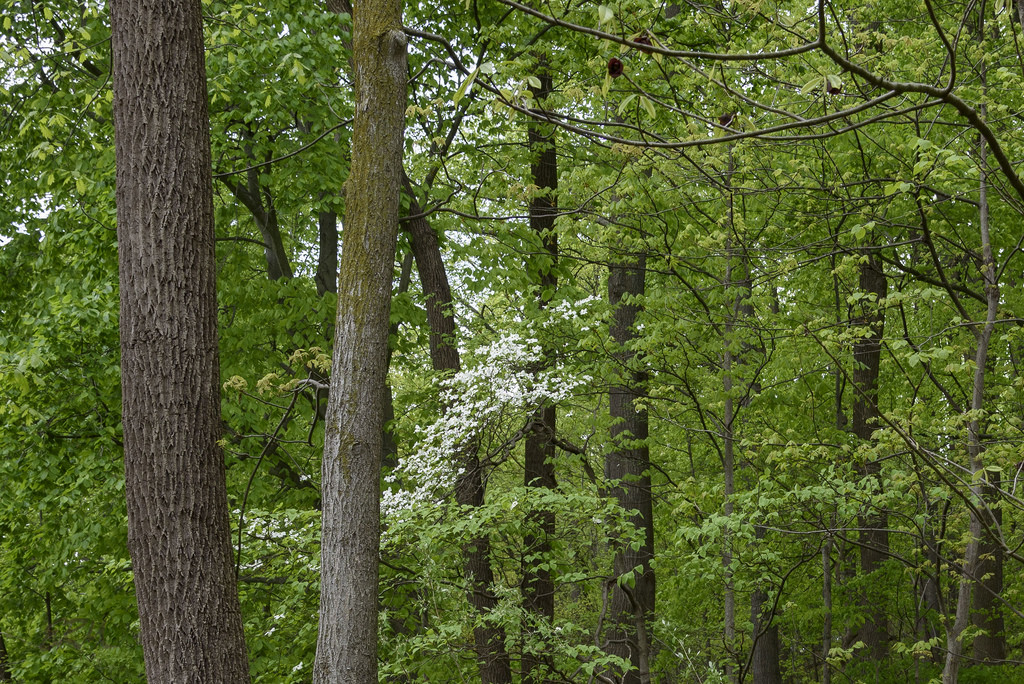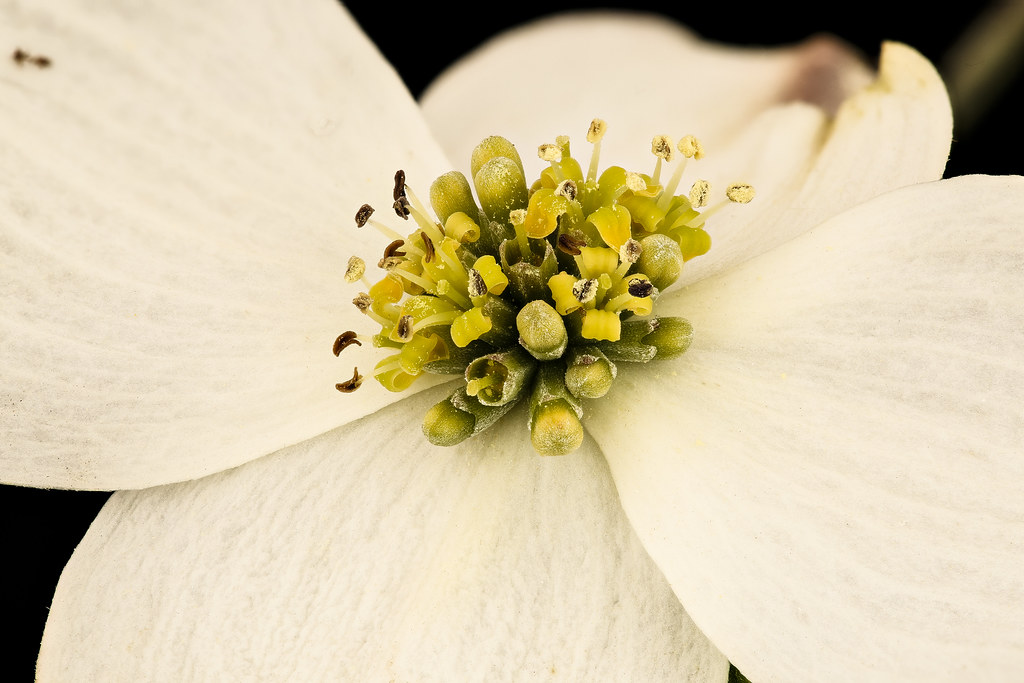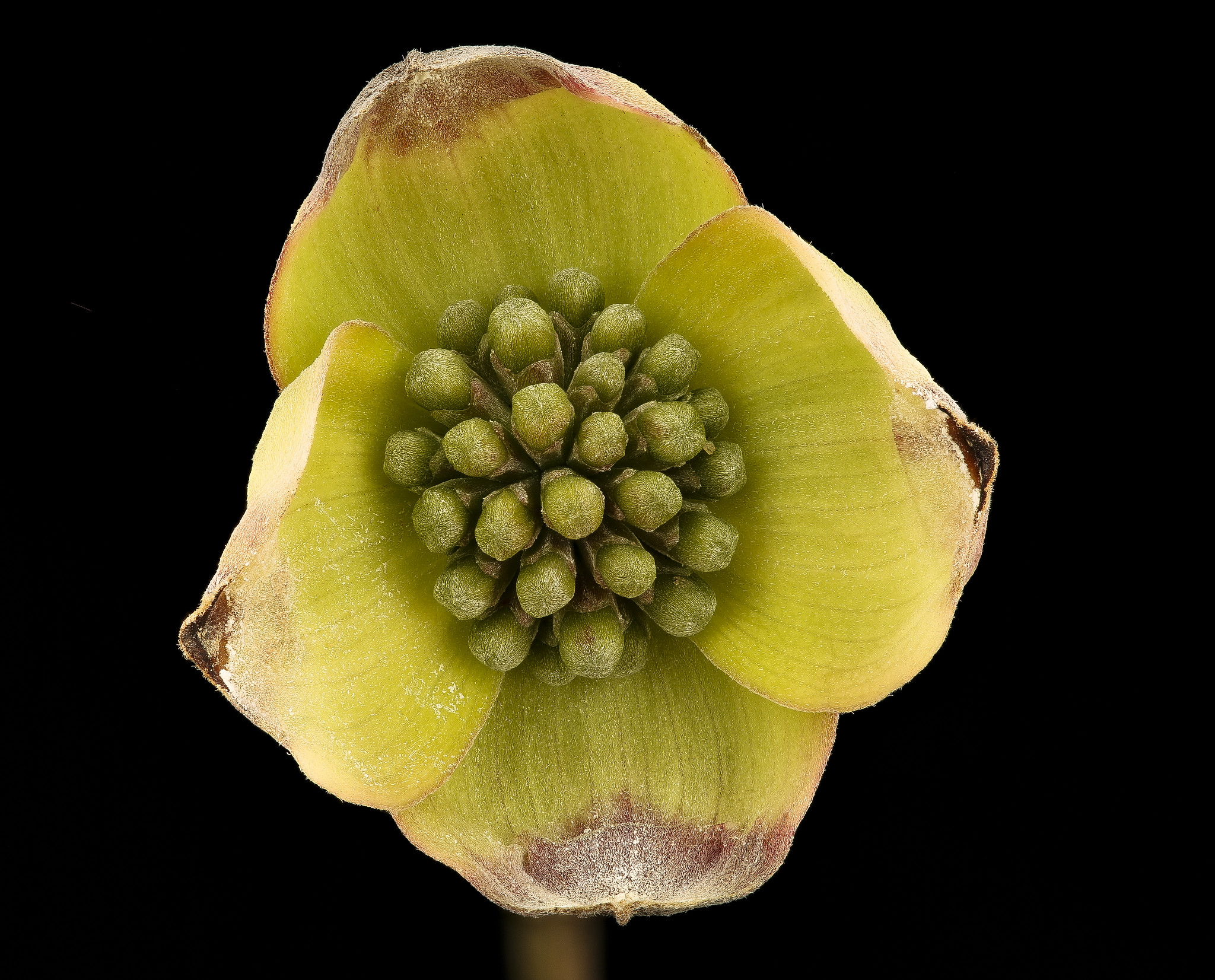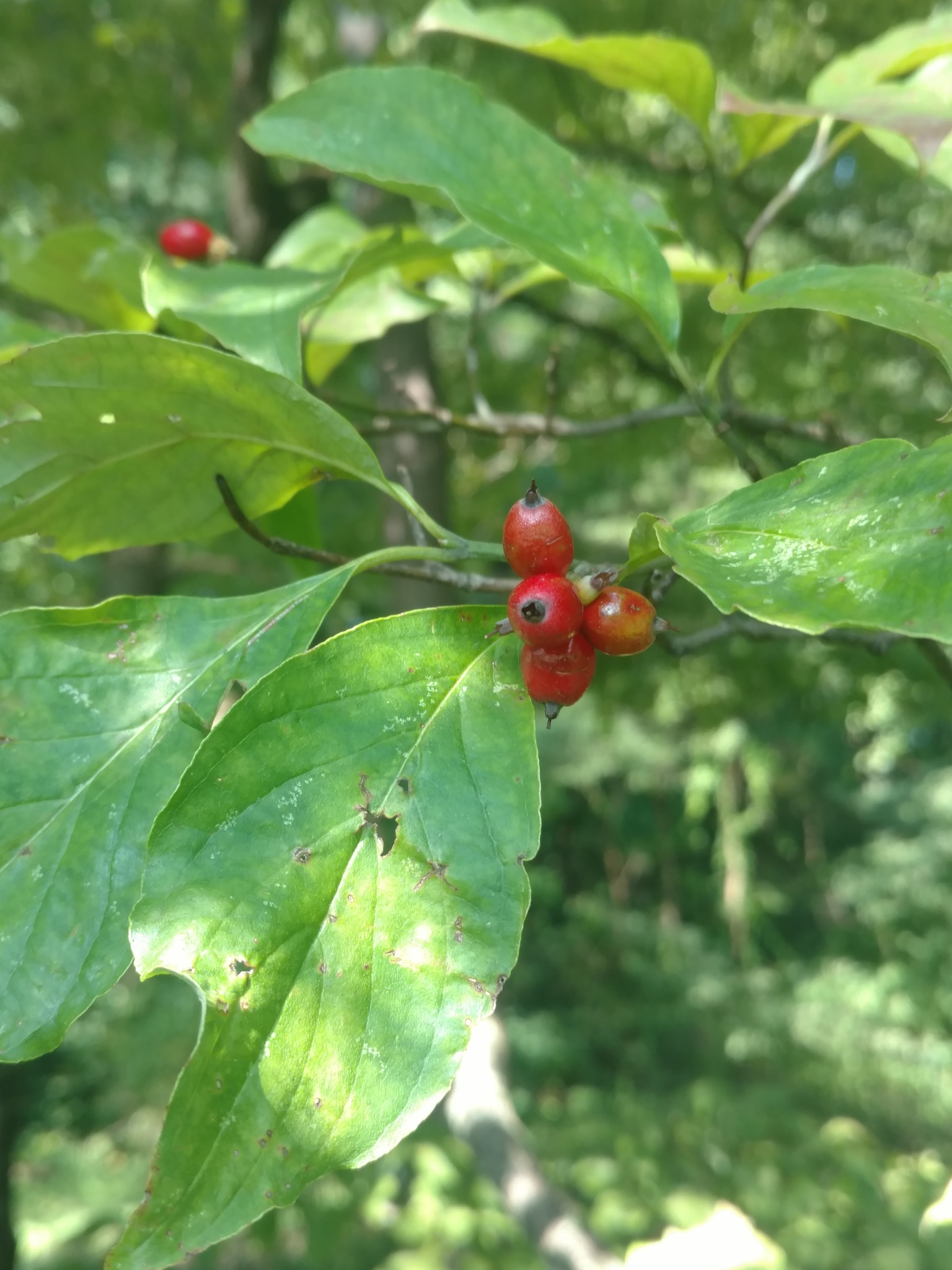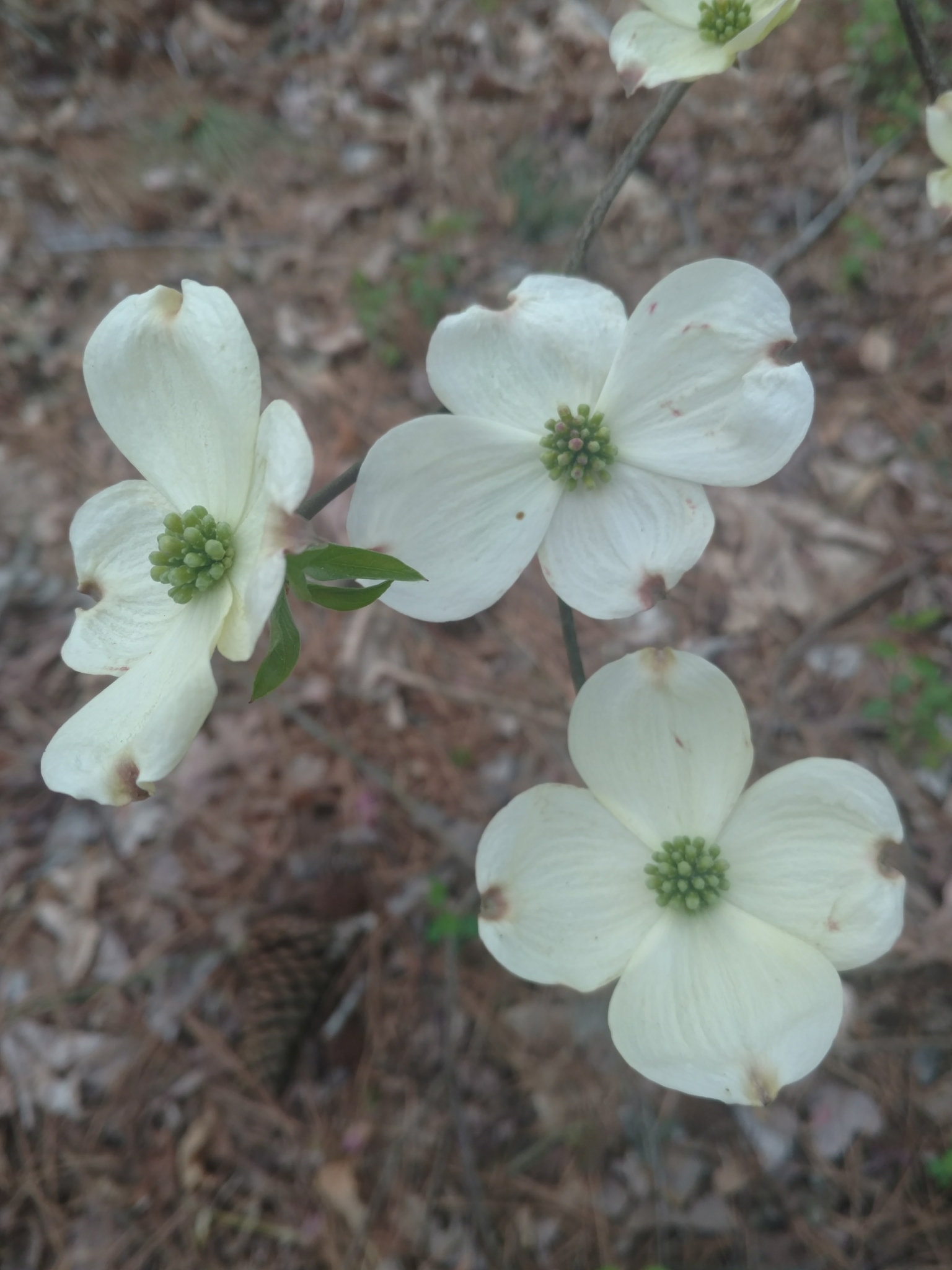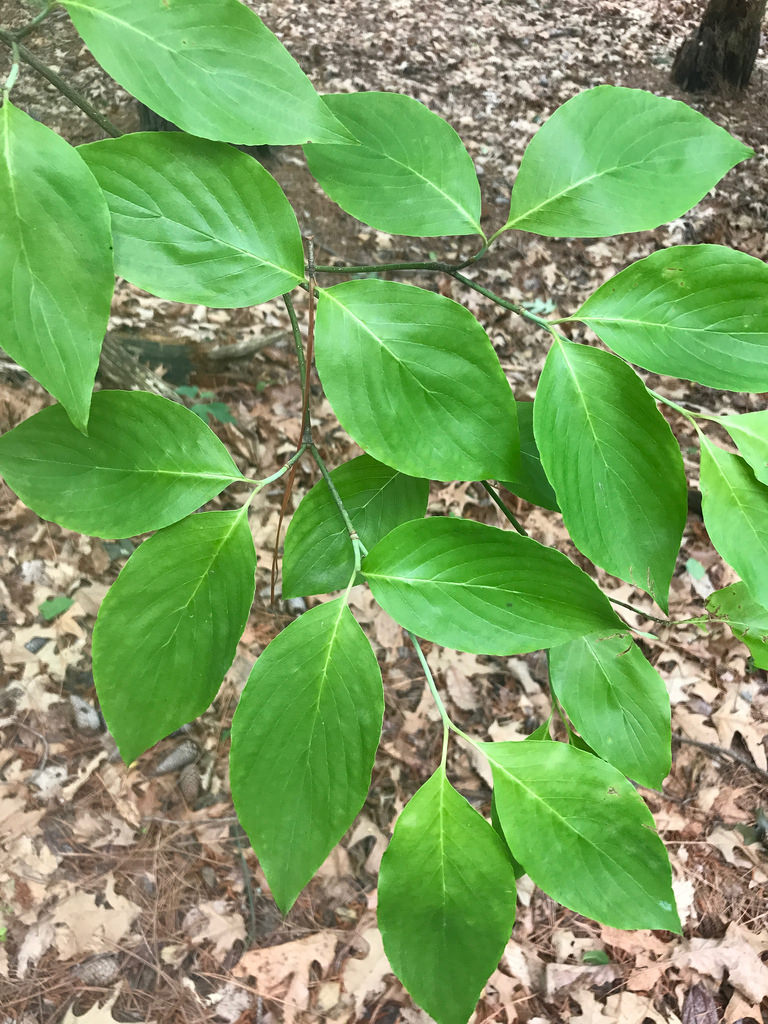Map Snapshot

























944 Records
Status
This eastern U.S. species is widespread and common in Maryland.
Description
The four, white petal-like structures are really bracts, and their open condition makes the tree look as though it's flowering. The actual flowers are the tiny structures clustered in the center. A cluster of obvious, red fruits (drupes) develop later in the season. In the fall and winter, the flower buds for the following year can be easily viewed. They are light-colored, biscuit-shaped structures covered by the bracts that will expand early in the spring (J. Hill/MNPS).
Relationships
Pollination is by beetles, bees, butterflies, and flies. Seed dispersal is by birds and mammals (J. Hill/MNPS).
Seasonality Snapshot
Source: Wikipedia
| Cornus florida | |
|---|---|
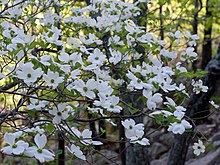
| |
| Flowering dogwood in Spring | |
| Scientific classification | |
| Kingdom: | Plantae |
| Clade: | Tracheophytes |
| Clade: | Angiosperms |
| Clade: | Eudicots |
| Clade: | Asterids |
| Order: | Cornales |
| Family: | Cornaceae |
| Genus: | Cornus |
| Subgenus: | Cornus subg. Cynoxylon |
| Species: | C. florida
|
| Binomial name | |
| Cornus florida | |

| |
| Natural range of Cornus florida | |
| Synonyms[3] | |
| |
Cornus florida, the flowering dogwood, is a species of flowering tree in the family Cornaceae native to eastern North America and northern Mexico. An endemic population once spanned from southernmost coastal Maine south to northern Florida and west to the Mississippi River.[4] The tree is commonly planted as an ornamental in residential and public areas because of its showy bracts and interesting bark structure.
Classification
[edit]The flowering dogwood is usually included in the dogwood genus Cornus as Cornus florida L., although it is sometimes treated in a separate genus as Benthamidia florida (L.) Spach. Less common names for C. florida include American dogwood, Florida dogwood, Indian arrowwood, Cornelian tree, white cornel, white dogwood, false box, and false boxwood.
Two subspecies are generally recognized:
| Image | Scientific name | Distribution |
|---|---|---|
 |
Cornus florida subsp. florida | eastern + south-central United States. |
 |
Cornus florida subsp. urbiniana (Rose) Rickett | northeastern Mexico (Nuevo León, Veracruz). |
Description
[edit]This section needs additional citations for verification. (September 2023) |
Flowering dogwood is a small deciduous tree growing to 10 m (33 ft) high, often wider than it is tall when mature, with a trunk diameter of up to 30 cm (1 ft). A 10-year-old tree will stand about 5 m (16 ft) tall. The leaves are opposite, simple, ovate, 6–13 cm (2.4–5.1 in) long and 4–6 cm (1.6–2.4 in) broad, with an apparently entire margin (actually very finely toothed, under a lens); they turn a rich red-brown in fall.
Flowering dogwood attains its greatest size and growth potential in the Upper South, sometimes up to 40 feet in height. At the northern end of its range, heights of 30–33 feet are more typical. Hot, humid summer weather is necessary for new growth to harden off in the fall.
The maximum lifespan of C. florida is about 80 years.[5]
The flowers are individually small, inconspicuous, and hermaphroditic, with four, greenish-yellow petals (not bracts) 4 mm (0.16 in) long. Around 20 flowers are produced in a dense, rounded, umbel-shaped inflorescence, or flower-head, 1–2 cm (0.39–0.79 in) in diameter. The flower-head is surrounded by four conspicuous large white, pink or red bracts (not petals), each bract 3 cm (1.2 in) long and 2.5 cm (0.98 in) broad, rounded, and often with a distinct notch at the apex.
When in the wild they can typically be found at the forest edge and frequently on dry ridges. While most of the wild trees have white bracts, some selected cultivars of this tree also have pink bracts, some even almost a true red. They typically flower in early April in the southern part of their range, to late April or early May in northern and high altitude areas. The similar Kousa dogwood (Cornus kousa), native to Asia, flowers about a month later.
The fruit is a cluster of two to ten separate drupes, (fused in Cornus kousa), each 10–15 mm (0.39–0.59 in) long and about 8 mm (0.31 in) wide, which ripen in the late summer and the early fall to a bright red, or occasionally yellow with a rosy blush. They are an important food source for dozens of species of birds, which then distribute the seeds. They are also a larval host plant for several moth varieties, including Eudeilinia herminiata, the dogwood thyatirid moth, Antispila cornifoliella, the stinging rose moth, the grand arches moth,[6] the pecan bark borer,[7] the dogwood borer,[8] the rosaceous leaf roller, the diamondback epinotia moth, spring azures,[9] cecropia moths,[9] and the Io moth. While not poisonous to humans, the fruit is extremely sour and unpleasant-tasting.[citation needed] Flowering dogwood is monoecious, meaning the tree has both male and female flowers, and all trees will produce fruit.
-
Cornus florida inflorescence, showing four large white bracts and central flower cluster.
-
Close up of a flower cluster showing the four pale green petals on each flower.
-
Fruits
-
Seeds
-
Bark
-
Leaf
Cultivation
[edit]Flowering dogwood does best horticulturally in moist, acidic soil in a site with some afternoon shade, but good morning sun. It does not do well when exposed to intense heat sources such as adjacent parking lots or air conditioning compressors. It also has a low salinity tolerance. The hardiness zone is 5–9 and the preferred pH is between 6.0 and 7.0.[10] In urban and suburban settings, care should be taken not to inflict mower damage on the trunk or roots, as this increases the tree's susceptibility to disease and pest pressure.[10]: 98–100 The common flowering dogwood has been placed on the endangered species list in Ontario.[11][12][13] Sites should be selected for reasonably well-drained, fertile soils; full sun is recommended in high-hazard areas (such as stream or pond banks). New plantings should be mulched to a depth of 5 to 10 cm (2 to 4 in), avoiding the stem. Dead wood and leaves should be pruned and completely removed and destroyed yearly. Plants should be watered weekly during droughts, with watering done in the morning, avoiding wetting the foliage. Registered fungicides can be applied when necessary, according to manufacturers instructions and advice of local Extension Service.[14]

Flowering dogwood is grown widely throughout the temperate world.
- Selected cultivars[15]
- 'Amerika Touch-O-Pink' – large bracts, tinged pink; large leaves; good disease resistance.
- 'Appalachian Spring' – large white bracts; red fall foliage; resistant to dogwood anthracnose.
- 'Autumn Gold' – white bracts; yellow fall color.
- 'Barton' – large white bracts; blooms at early age; resistant to stem canker and powdery mildew.
- 'Bay Beauty' – double white bracts; resists heat and drought; good for Deep South.
- 'Cherokee Daybreak' – white bract; vigorous grower with variegated leaves.
- 'Cherokee Chief' – red bracts; red new growth.[16]
- 'Cherokee Brave' – Even redder than 'Cherokee Chief', smaller bracts but dark red color; consistently resistant to powdery mildew.
- 'Cherokee Princess' – vigorous white bracts, industry standard for white flowers.
- 'Cherokee Sunset' – purplish-red bracts; variegated foliage.
- 'Gulf Coast Pink' – best pink flowering dogwood in Florida – northern part only.
- 'Hohman's Gold' – white bracts; variegated foliage.
- 'Jean's Appalachian Snow' – large, overlapping white bracts w/ green flowers; very resistant to powdery mildew.
- 'Karen's Appalachian Blush' – delicate white bracts edged in pink; some powdery mildew resistance.
- 'Kay's Appalachian Mist' – stiff, creamy white bracts; red fall foliage; good resistance to powdery mildew.
- 'Plena' – double white bracts; spot anthracnose-resistant.
- 'Purple Glory' – red bracts; purple foliage; spot anthracnose-resistant but susceptible to stem canker.
- 'Weaver White' – large white blooms; large leaves; candelabra shape; good in north-central Florida.
Propagation
[edit]

Cornus florida is easily propagated by seeds, which are sown in the fall into prepared rows of sawdust or sand, and emerge in the spring. Germination rates for good clean seed should be near 100% if seed dormancy is first overcome by cold stratification treatments for 90 to 120 days at 4 °C (39 °F).[10]: 100–102 [17] Flowering dogwood demonstrates gametophytic self-incompatibility, meaning that the plants can't self-fertilize. This is important for breeding programs as it means that it is not necessary to emasculate (remove the anthers from) C. florida flowers before making controlled cross-pollinations. These pollinations should be repeated every other day, as the flowers must be cross-pollinated within one or two days of opening for pollinations to be effective.[18]

Softwood cuttings taken in late spring or early summer from new growth can be rooted under mist if treated with 8,000 to 10,000 ppm indole-3-butyric acid (IBA). In cold climates, potted cuttings must be kept in heated cold frames or polyhouses the following winter to maintain temperatures between 0 and 7 °C (32 and 45 °F). Although rooting success can be as high as 50–85%, this technique is not commonly used by commercial growers. Rather, selected cultivars are generally propagated by T-budding in late summer or by whip grafting in the greenhouse in winter onto seedling rootstock.[17][10]: 102
Micropropagation of flowering dogwood is now used in breeding programs aiming to incorporate resistance to dogwood anthracnose and powdery mildew into horticulturally and economically important cultivars. Nodal (axillary bud) sections are established in a culture of Woody Plant Medium (WPM) amended with 4.4 μmol/L 6-Benzyladenine (BA) to promote shoot growth.[19] Rooting of up to 83% can be obtained when 5–7 week-old microshoots are then transferred to WPM amended with 4.9 μmol/L IBA.[20]
Diseases
[edit]Dogwood anthracnose caused by the fungi Discula destructiva has caused severe mortality of dogwoods.[21] In regions where dogwood anthracnose is a problem, homeowners and public land managers are encouraged to know the symptoms and inspect trees frequently. The selection of healthy, disease-free planting stock is essential and transplanting trees from the forest, particularly from mountain forests, should be avoided.[22] Species of Phytophthora cause root rot.[23]
Historical uses
[edit]Native Americans used the bark and roots in a remedy for malaria; a red dye was also extracted from the roots.[24] The species has been used in the production of inks, scarlet dyes, and as a quinine substitute. The hard, dense wood has been used for products such as golf club heads, mallets, wooden rake teeth, tool handles, jeweler's boxes and butcher's blocks.[25][10]: 100 Cornus florida is the state tree and flower of Virginia,[26] the state tree of Missouri, and state flower of North Carolina.[27][28] It was used to treat dogs with mange, which may be how it got its name.[28] The red berries are not edible, despite some rumors otherwise.[29]
In 1915, 40 dogwood saplings were donated by the U.S. to Japan in the 1912-15 exchange of flowers between Tokyo and Washington, D.C. While the cherry blossom trees survived the ensuing sour relations of these two countries and are the main feature of the National Cherry Blossom Festival, all dogwood trees in Tokyo died except the one that had been planted in an agriculture high school. In 2012, the United States sent 3,000 dogwood saplings to Japan to commemorate the 100th anniversary of the Washington, D.C., cherry trees given as a gift to the U.S. by Japan in 1912.[30][31]
References
[edit]- ^ Stritch, L. (2018). "Cornus florida". IUCN Red List of Threatened Species. 2018: e.T61990536A61990538. doi:10.2305/IUCN.UK.2018-2.RLTS.T61990536A61990538.en. Retrieved November 19, 2021.
- ^ "NatureServe Explorer". Retrieved May 6, 2021.
- ^ "Cornus florida L." The Plant List.
- ^ "Cornus florida County distribution map". The Biota of North America Program. 2014.
- ^ "Flowering Dogwood". Bernheim Arboretum and Research Forest. Archived from the original on September 27, 2020. Retrieved February 19, 2021.
- ^ "Lacanobis grandis species information". bugguide.net.
- ^ "Species Synanthedon geliformis - Pecan Bark Borer - Hodges#2547". bugguide.net.
- ^ "Species Synanthedon scitula - Dogwood Borer - Hodges#2549". bugguide.net.
- ^ a b Adelman, Lauren (July 5, 2017). "The Joy of Butterfly Host Plants". Lewis Ginter Botanical Garden. Retrieved April 26, 2020.
- ^ a b c d e Cappiello P, Shadow D (2005). Dogwoods: The Genus Cornus.. Portland: Timber Press.
- ^ "Eastern flowering dogwood". Species at Risk. Government of Ontario. Retrieved March 4, 2019.
- ^ "Species Profile (Eastern Flowering Dogwood) - Species at Risk Public Registry". www.registrelep-sararegistry.gc.ca. Government of Canada, Environment. Archived from the original on June 5, 2017. Retrieved April 23, 2017.
- ^ "USDA Plants Database" (PDF).
- ^ Anderson RL, Knighten JL, Windham M, Langdon K, Hendrix F, Roncadori R (1994). "Dogwood anthracnose and its spread in the South" (PDF). Project Report R8-PR 26. Atlanta, GA: USDA Forest Service. p. 10.
- ^ Nowicki M, Boggess SL, Saxton AM, Hadziabdic D, Xiang QJ, Molnar T, Huff ML, Staton ME, Zhao Y, Trigiano RN (October 23, 2018). Heinze B (ed.). "Haplotyping of Cornus florida and C. kousa chloroplasts: Insights into species-level differences and patterns of plastic DNA variation in cultivars". PLOS ONE. 13 (10): e0205407. Bibcode:2018PLoSO..1305407N. doi:10.1371/journal.pone.0205407. PMC 6198962. PMID 30352068.
- ^ "Cornus florida 'Cherokee Chief'". RHS Plant Selector. The Royal Horticultural Society. Retrieved July 17, 2013.
- ^ a b Hartmann, HT, DE Kester, FT Davies, RL Geneve. 2002. Hartmann and Kester's Plant Propagation: Principles and Practices, 7th Edition. Prentice Hall, Upper Saddle River, NJ. pp. 769.
- ^ Reed SM (2004). "Self-incompatibility in Cornus florida". HortScience. 39 (2): 335–338. doi:10.21273/HORTSCI.39.2.335.
- ^ Kaveriappa KM, Phillips LM, Trigiano RN (April 1997). "Micropropagation of flowering dogwood (Cornus florida) from seedlings". Plant Cell Reports. 16 (7): 485–489. doi:10.1007/BF01092771. PMID 30727637. S2CID 40422365.
- ^ Sharma AR, Trigiano RN, Witte WT, Schwarz OJ (January 2005). "In vitro adventitious rooting of Cornus florida microshoots". Scientia Horticulturae. 103 (3): 381–5. doi:10.1016/j.scienta.2004.06.014.
- ^ Connor, Kristina Frances (2006). Proceedings of the 13th Biennial Southern Silvicultural Research Conference: Memphis, Tennessee, February 28-March 4, 2005. USDA Forest Service, Southern Research Station.
- ^ Anderson RL, Knighten JL, Windham M, Langdon K, Hedrix F, Roncadori R. "Dogwood Anthracnose and its Spread in the South" (PDF). United States Department of Agriculture, Forest Service, Southern Region. Retrieved September 12, 2023.
- ^ Report. United States Department of Agriculture, Forest Service, Northern Region. 1998.
- ^ Little, Elbert L. (1980). The Audubon Society Field Guide to North American Trees: Eastern Region. New York: Knopf. p. 616. ISBN 0-394-50760-6.
- ^ Petrides GA (1972). A field guide to trees and shrubs; field marks of all trees, shrubs, and woody vines that grow wild in the northeastern and north-central United States and in southeastern and south-central Canada. The Peterson field guide series. Vol. 11. Boston: Houghton Mifflin. p. 106.
- ^ "White Dogwood". Virginia Department of Forestry. Archived from the original on December 7, 2011. Retrieved April 7, 2012.
- ^ "Cornus florida". Missouri Botanical Garden. Retrieved April 7, 2012.
- ^ a b "State Flower--Dogwood" (PDF). North Carolina Museum of History. Archived from the original (PDF) on July 20, 2012. Retrieved April 7, 2012.
- ^ "Dogwood Tree - Beautiful Flowers, Unique Fruits". Eat The Planet. January 11, 2017. Retrieved April 26, 2019.
- ^ "U.S. eyes 3,000 dogwoods for 'sakura' anniversary. The Japan Times. Posted: Jan. 17, 2012". Japantimes.co.jp. January 17, 2012. Archived from the original on July 13, 2012. Retrieved March 28, 2014.
- ^ "'Dogwood Diplomacy:' U.S. To Send Japan 3,000 Trees. NPR". www.npr.org. May 1, 2012. Retrieved March 19, 2024.
External links
[edit]- Bioimages: Cornus florida
- Flora of Pennsylvania
- Floridata: Cornus florida
- Missouriplants: Cornus florida
- University of Connecticut Plant Database: Cornus florida
- United States Department of Agriculture, National Forest Service: Cornus florida
- University of California @ Davis, Integrated Pest Management Online: Dogwood pest management
- Cornell University, Integrated Pest Management, Dogwood Borer
- United States Department of Agriculture, National Forest Service, St. Paul Field Office, How to Identify and Control Dogwood Anthracnose
- Virginia State University Cooperative Extension, Foliar Diseases of Dogwood
- flowering dogwood - Interactive Native Range Distribution Map of Cornus florida
- "Cornus florida". Plants for a Future.
